“Perimenopause usually happens sometime in your 40s.
On average, it lasts four to six years,
but it can last from one to 10 years”.1
Umbrella
What may the Perimenopause Umbrella include?
Depending on the Source (DotS) this Umbrella may include:
- Climacteric
- Late Reproductive Stage (LRS)
- Menopausal Transition/Transitional Phase
- Menopause Transition/Transitional Phase
- Perimenopausal/Peri-menopausal Changes
- Perimenopause/Peri-menopause
- The Transition To Menopause
- Time Leading Up To Menopause
Definition
DotS the definition of perimenopause may vary.
In Menopause: Key Facts the World Health Organization’s definition is:
- “The menopausal transition can be gradual, usually beginning with changes in the menstrual cycle. ‘Perimenopause’ refers to the period from when these signs are first observed and ends one year after the final menstrual period”.2
On page four in Menopause Terminology: Glossary of Terms [English] the International Menopause Society’s definition is:
In The 2023 Practitioner’s Toolkit for Managing Menopause: Definitions, published online 30 October 2023, the authors’ definition is:
- “Perimenopause is the time from the onset of cycle irregularity through until 12 months after the final menstrual period”.4
In Menopause FAQs: An Introduction To Menopause – Q. What Is Perimenopause? the North American Menopause Society’s (NAMS) definition is:
First Sign
What is usually the first sign of perimenopause?
In Menopause: Symptoms – Common Symptoms of Menopause and Perimenopause: Changes To Your Periods the NHS explain:
Eventually you’ll stop having periods altogether”.6
Physical Symptoms
What may some physical symptoms include?
In Symptoms of Menopause: Physical and Emotional Symptoms — Physical Symptoms the (Australian) Jean Hailes for Women’s Health (JH) explain:

“Physical symptoms may include:
- Irregular periods
- Hot flushes
- Night sweats
- Sleep problems
- Sore breasts
- Itchy, crawly or dry skin
- Exhaustion and fatigue
- Dry vagina
- Loss of sex drive (libido)
- Headaches or migraines
- More pronounced premenstrual tension (PMS)
- Aches and pains
- Bloating
- Urinary problems
- Weight gain due to a slower metabolism”.7
Emotional Symptoms
What may some emotional symptoms include?
In Symptoms of Menopause: Physical and Emotional Symptoms — Psychological and Emotional Symptoms the JH explain:
- Feeling irritable or frustrated
- Feeling anxious
- Difficulty concentrating
- Brain fog
- Forgetfulness
- Lowered mood
- Mood swings
- Feeling you can’t cope as well as you used to”.8
Common or Not
How common are menopausal symptoms?
On page one in Joint Position Statement By the British Menopause Society, Royal College of Obstetricians and Gynaecologists and Society for Endocrinology on Best Practice Recommendations for the Care of Women Experiencing the Menopause one of the recommendations is:
Start
When may perimenopause start?
In Perimenopause: Symptoms & Causes – Overview the (United States) Mayo Clinic elaborate on:
In What Is Menopause? Perimenopause, Menopause and Postmenopause – Perimenopause? the JH also note:
Duration
How long can perimenopause last?
In What Is Menopause? What Is Perimenopause (the Menopausal Transition)? the Australasian Menopause Society elaborate on:
Menopause
When does perimenopause stop and menopause officially start?
In Perimenopause: Symptoms & Causes – Overview the Mayo Clinic explain:
Hormone Therapy
Can hormone therapy help improve symptoms of menopause?
In Mayo Clinic Q and A: Perimenopause Transitions and Concerns, dated 20 July 2023, the Mayo Clinic note:
Health Care Provider
What if I would like help with perimenopause?
If you would like help with perimenopause, it may be in your best interest to choose to talk to your health care provider about this.
In What Is Menopause? When To See Your Doctor the JH explain:
- Irregular periods
- Heavy bleeding
- Bleeding after menopause
- Increased premenstrual syndrome (PMS) symptoms
- Menopausal symptoms, such as hot flushes, that interfere with your daily life”.15
In Menopause: Diagnosis & Treatment – Treatment the Mayo Clinic elaborate on:
Health Topics A-Z
Where may I find Health Topics A-Z related to Perimenopause?
In Health Topics A-Z you may find:
Links
Where may I find Links related to Perimenopause?
Your Country may have Links similar to:
Links
This Links List to third party websites is neither comprehensive nor exhaustive. Inclusion on this Links List does not imply endorsement or recommendation. Non-inclusion on this Links List does not imply non-endorsement or non-recommendation. Third party websites are not under the control of Meno Martha International Menopause Directory. Third party websites may contain explicit medical images and/or sexual references. Please read Meno Martha International Menopause Directory’s Links Policy before proceeding to a Link. Please contact Webmaster if you experience a problem with a Link.New or Updated
- HRT Is Not #contraception and So If You Are Perimenopausal Then Added Contraception Is Needed [07 May 2024]
- Hormones and Brain Health | Dr Louise Newson [02 July 2024]
- Mayo Clinic Minute: Perimenopause and Menopause [13 May 2024] [+ Video Courtesy: Mayo Clinic News Network]
- Menopause and HRT: Fact and Fiction [31 May 2024]
- Video Series-2024: Preparing for Your Menopause Health Care Visit [13 January 2024]
- Videos & Podcasts: Videos – Interviews: Metabolic Syndrome in Midlife Women [April 2024]
- Webinars: Previous – Perimenopausal Contraception
- 5 Things You Didn’t Realise You Need To Know About Perimenopause
- A Guide To Birth Control In Your 40s and 50s
- ACOG Explains: Managing Menopause Symptoms [American College of Obstetricians and Gynecologists]
- An Online Survey of Perimenopausal Women To Determine Their Attitudes and Knowledge of the Menopause
- Bioidentical Hormones: Are They Safer?
- CAMS Menopause Hour – Perimenopause: A Clinical Challenge
- Contraception and the Menopause
- Diagnosing Menopause
- Diagnostic Tests for Menopause
- Do My Period Changes Mean Perimenopause?
- Does Having Hot Flashes Mean I’ve Started Menopause?
- EMAS On-Demand Webinars [European Menopause and Andropause Society] [Multiply Languages]: Benefits of Oral Combined MHT for Estrogen Deficiency Symptoms Treatment (EN)
- Effects of Mind-Body Exercise on Perimenopausal and Postmenopausal Women: A Systematic Review and Meta-Analysis
- Everything You Need To Know About Perimenopause
- FAQs: Perimenopausal Bleeding and Bleeding After Menopause
- Find A Menopause Practitioner [United States and Other]
- Find An AMS Doctor [Australian Members and New Zealand Members]
- Find Your Nearest BMS Menopause Specialist [British Menopause Society]
- HRT Is Not #contraception and So If You Are Perimenopausal Then Added Contraception Is Needed
- Hormone Therapy: Four Things A Mayo Clinic Women’s Health Specialist Wants You To Know [+ Video Courtesy: Mayo Clinic News Network. Name Super/CG: Taryn Smith, M.D./Internal Medicine/Mayo Clinic]
- Hormones and Brain Health | Dr Louise Newson
- Hot Flashes
- Hot Flashes: What Can I Do? [+ Video: What Are the Signs and Symptoms of Menopause?]
- How Is Perimenopause Treated?
- How To Deal With Perimenopause Cramps
- How To Find Relief for Hot Flashes At Night
- How To Know If You Are In Menopause
- How To Talk To Your Doctor About Midlife Brain Fog
- How To Tell You’re Near the End of Perimenopause
- Is Menopause Making Me Put on Weight? No, But It’s Complicated
- It’s Not Alzheimer’s Disease: It’s Perimenopause
- Joint Position Statement By the British Menopause Society, Royal College of Obstetricians and Gynaecologists and Society for Endocrinology on Best Practice Recommendations for the Care of Women Experiencing the Menopause
- Later Years (Around 50 Years and Over): Menopause and Post Menopause Health – Signs and Symptoms of Menopause [+ Video: Talking Menopause With Your GP] [Other Languages and Formats]
- Later Years (Around 50 Years and Over): Menopause and Post Menopause Health – Supporting Someone Through the Menopause [+ Video: Men Don’t Need To Know About Menopause] [Other Languages and Formats]
- Let’s Talk About Perimenopause
- Management of Perimenopausal and Menopausal Symptoms
- Mastering Midlife Mood Changes With Marlene Freeman, MD
- Mayo Clinic Minute: Help With Hot Flashes Due To Menopause [+ Video Courtesy: Mayo Clinic News Network]
- Mayo Clinic Minute: How Lifestyle Changes May Help Manage Menopause Symptoms [+ Video]
- Mayo Clinic Minute: Perimenopause and Menopause [+ Video]
- Mayo Clinic Q and A: Perimenopause Transitions and Concerns
- Menopause
- Menopause
- Menopause Checklist Podcast
- Menopause Map: Downloadable Resources – My Personal Path Print Tools: Symptom Tracker
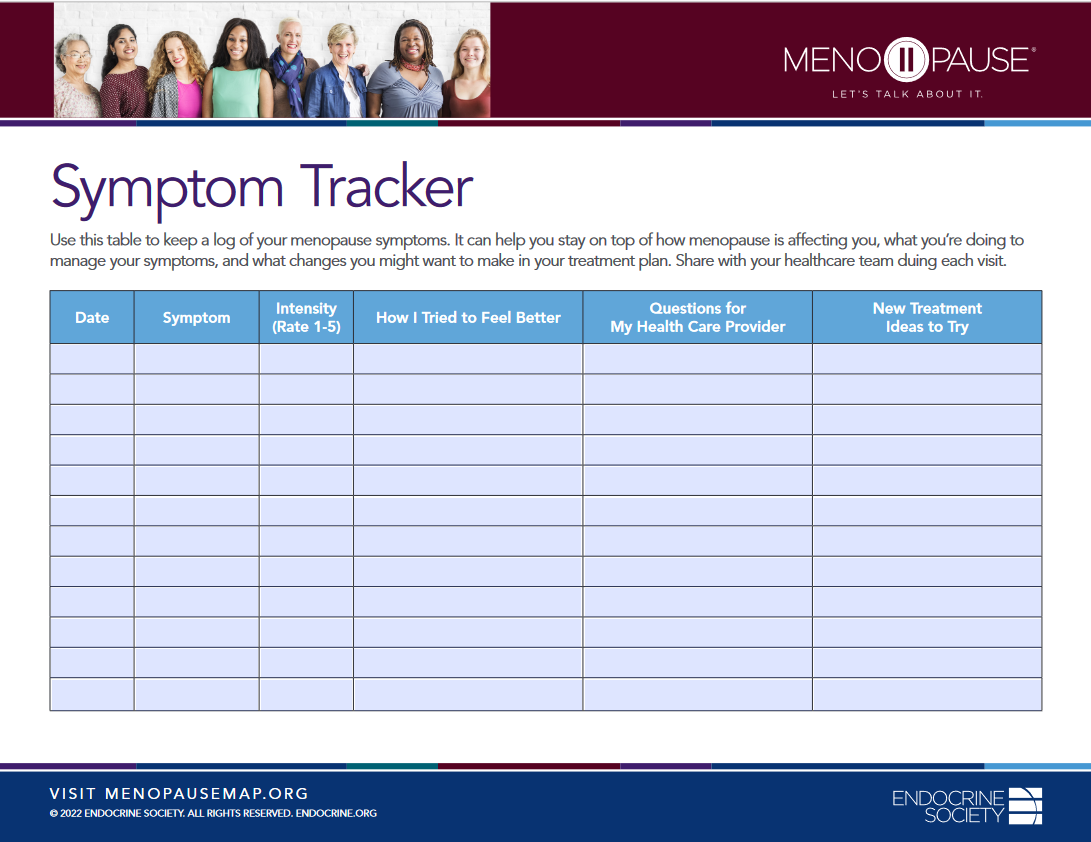
- Menopause Map: Downloadable Resources – Stages of Menopause: Perimenopause
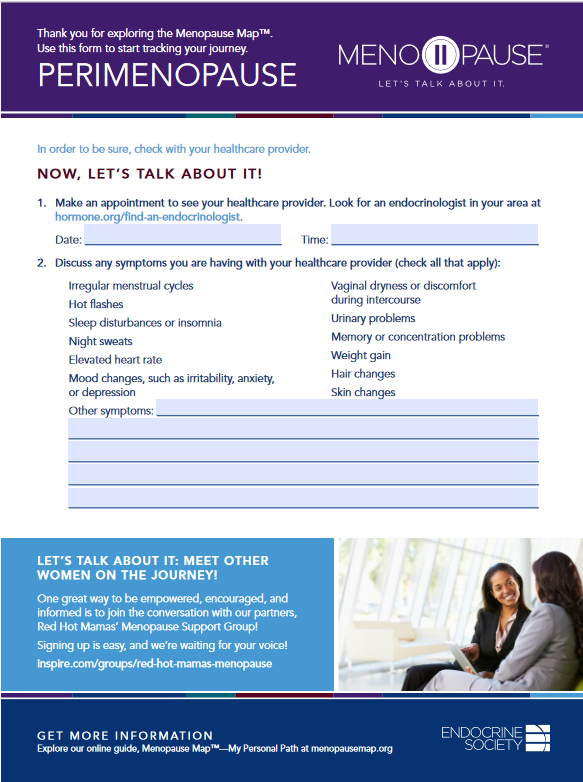
- Menopause Patient Information [Videos] 1. What Is Menopause?
- Menopause Patient Information [Videos] 2. Talking To Your GP About Menopause
- Menopause Preparedness Toolkit Video Series: Understanding Menstrual Health and Menopause
- Menopause Preparedness Toolkit Video Series: What Is Menopause?
- Menopause Preparedness Toolkit: A Woman’s Empowerment Guide
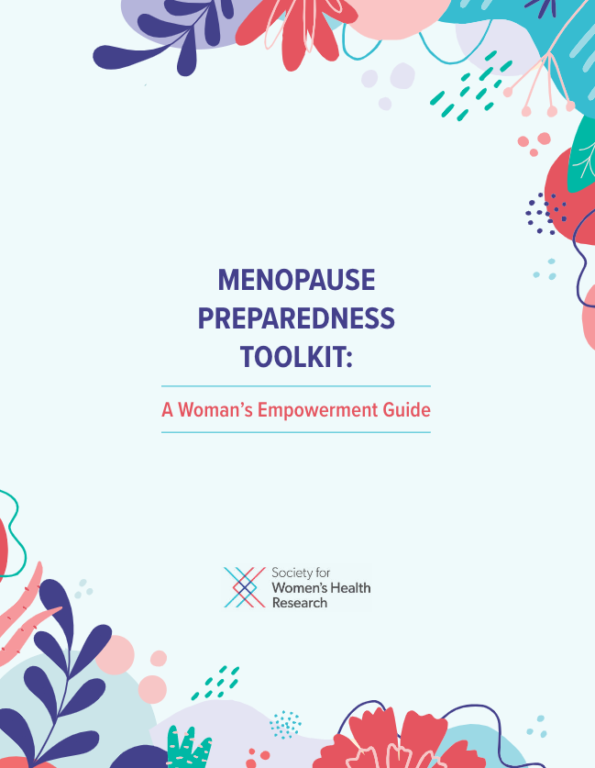
- Menopause Symptoms: Mayo Clinic Expert Outlines Hormone and Nonhormonal Therapies
- Menopause Treatments: What Works, What Doesn’t
- Menopause and HRT: Fact and Fiction [Video]
- Menopause and Mental Health
- Menopause: Ensuring A Tranquil Transition
- Menopause: Things You Can Do
- Menopause: Understanding the Changes and Finding Relief | Dr Susan Davis | The Proof Podcast EP #256
- Menstrual Calendar
- Mood and the Menopause
- Mymenoplan.org [My Menoplan, United States]
- My Periods Have Changed. Is Menopause Around the Corner?
- Navigating Menopause: Expert Insights and Solutions | Dr Susan Davis | The Proof Podcast EP 245
- Navigating Menopause: Honest Answers To All Your Questions [+ Video: What To Expect in Menopause]
- Night Sweats
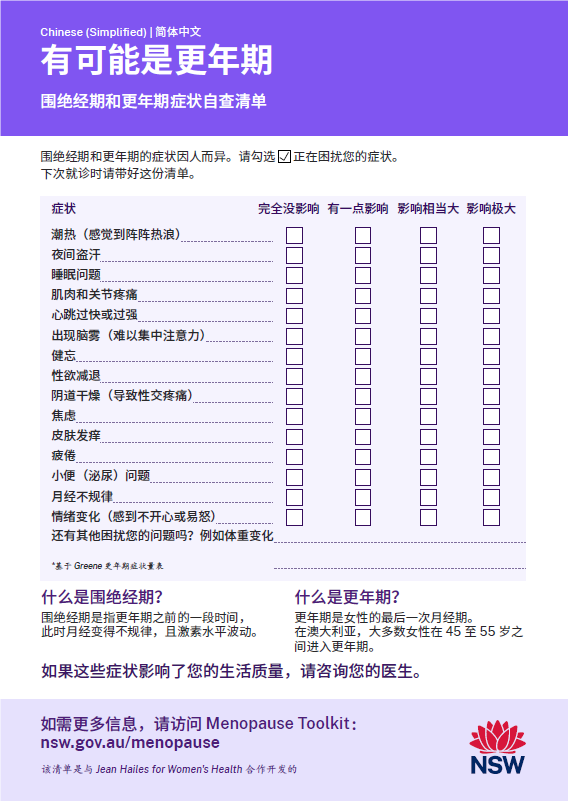 Nonhormone Treatments for Hot Flashes and Night Sweats
Nonhormone Treatments for Hot Flashes and Night Sweats- “Not feeling like myself” In Perimenopause — What Does It Mean? Observations From the Women Living Better Survey
- Peri-Menopause and Irregular Periods
- Perimenopausal and Postmenopausal Bleeding
- Perimenopause
- Perimenopause
- Perimenopause Usually Begins In Your 40s. How Do You Know If It Has Started?
- Perimenopause and Menopause Checklist: Translated Checklists
- Perimenopause and Menopause Symptom Checklist
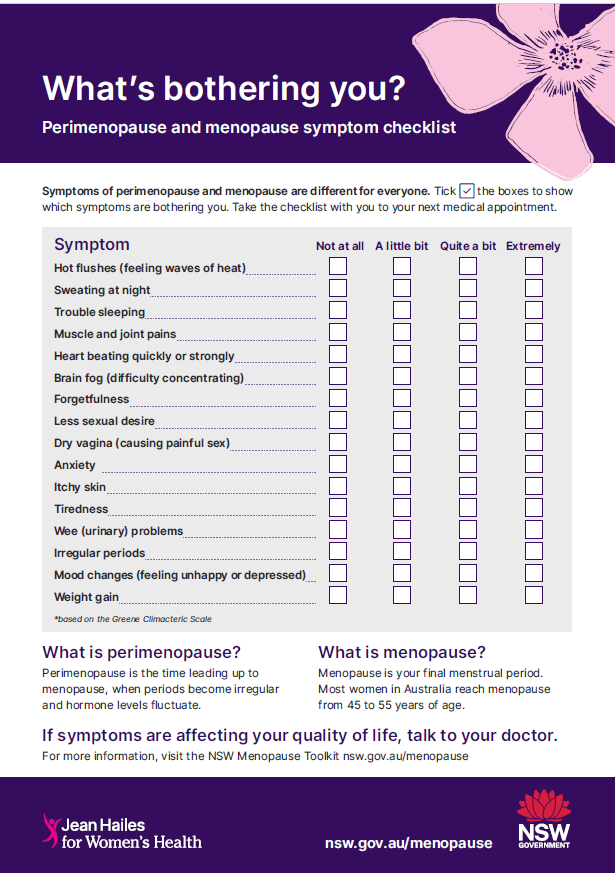
- Perimenopause: Rocky Road To Menopause
- Promoting Good Mental Health Over the Menopause Transition
- Surprising Menopause Symptoms Revisited | Dr Louise Newson
- The 2023 Practitioner’s Toolkit for Managing Menopause
- The Importance of Nutrition In Menopause and Perimenopause—A Review
- The Lancet: Series From the Lancet Journal – Menopause 2024
- The Truth About Menopause Supplements | Dr Sarah Berry
- Tips To Help Manage Menopause Symptoms
- Using Natural Therapies In the Menopause Transition – Webinar
- Video Series-2023: NAMS 2023 Nonhormone Therapies Position Statement for Bothersome Menopause Symptoms
- Video Series-2023: New FDA-Approved Nonhormone Option for the Treatment of Hot Flashes
- Video Series-2024: Preparing for Your Menopause Health Care Visit
- Videos & Podcasts: Videos – Interviews: Metabolic Syndrome in Midlife Women
- Videos and Podcasts: Videos – Interviews: A Simple Approach To Menopause: The Menopause Quick Six (www.MQ6.ca)
- Vital [Vital Is the Virtual Registry of Peri-/Menopause In Australia]
- Webinars: Previous – Non-Hormonal Pharmacological Interventions For VMS
- Webinars: Previous – Non-Pharmacological Interventions For VMS
- Webinars: Previous – Perimenopausal Contraception
- What Are The Symptoms of Perimenopause? | Dr. Nighat Arif Explains | Menopause Masterclass
- What Everyone Should Know About Menopause Symptoms
- What Is Menopause?
- What Is Menopause?
- What Is Menopause? [+ Video]
- What To Expect In Each Stage of Menopause
- Why Didn’t Anyone Tell Me This? Episode 3: Dr Annice Mukherjee: Your Essential Menopause Toolkit
- Why Is FSH Not Needed for Diagnosis of Menopause
Sources
Where may I find the Sources quoted?
You may find the Sources quoted at:
Sources
- What Is Menopause? Perimenopause, Menopause and Postmenopause – Perimenopause? Last Updated: 18 January 2024 | Last Reviewed: 19 August 2022. Jean Hailes for Women’s Health https://www.jeanhailes.org.au/health-a-z/menopause/about-menopause Accessed: 16 May 2024
- Menopause: Key Facts. 17 October 2022. World Health Organization https://www.who.int/news-room/fact-sheets/detail/menopause Accessed: 16 May 2024
- Glossary of Terms [English]. October 2022:4. International Menopause Society https://www.imsociety.org/wp-content/uploads/2022/10/IMS-English-Factsheet-4-glossary.pdf Accessed: 16 May 2024
- Davis, S. R., Taylor, S., Hemachandra, C., Magraith, K., Ebeling, P. R., Jane, F., and Islam, R. M. The 2023 Practitioner’s Toolkit for Managing Menopause: Definitions. Published Online: 30 October 2023 https://www.tandfonline.com/doi/full/10.1080/13697137.2023.2258783 Accessed: 16 May 2024
- Menopause FAQs: An Introduction To Menopause – Q. What Is Perimenopause? North American Menopause Society https://www.menopause.org/for-women/menopause-faqs-an-introduction-to-menopause Accessed: 16 May 2024
- Menopause: Symptoms – Common Symptoms of Menopause and Perimenopause: Changes To Your Periods. Page Last Reviewed: 17 May 2022. NHS https://www.nhs.uk/conditions/menopause/symptoms/ Accessed: 16 May 2024
- Symptoms of Menopause: Physical and Emotional Symptoms — Physical Symptoms. Last Updated: 21 April 2024 | Last Reviewed: 19 August 2022. Jean Hailes for Women’s Health https://www.jeanhailes.org.au/health-a-z/menopause/menopause-symptoms#physical-and-emotional-symptoms Accessed: 16 May 2024
- Symptoms of Menopause: Physical and Emotional Symptoms — Psychological and Emotional Symptoms. Last Updated: 21 April 2024 | Last Reviewed: 19 August 2022. Jean Hailes for Women’s Health https://www.jeanhailes.org.au/health-a-z/menopause/menopause-symptoms#physical-and-emotional-symptoms Accessed: 16 May 2024
- Hamoda, H., Mukherjee, A., Morris, E., Baldeweg, S. E., Jayasena, C. N., Briggs, P., Moger, S. Joint Position Statement By the British Menopause Society, Royal College of Obstetricians and Gynaecologists and Society for Endocrinology on Best Practice Recommendations for the Care of Women Experiencing the Menopause. First Published Online 10 June 2022:1 https://journals.sagepub.com/doi/full/10.1177/20533691221104879 Accessed: 16 May 2024
- Perimenopause: Symptoms & Causes – Overview. 25 May 2023. Mayo Clinic https://www.mayoclinic.org/diseases-conditions/perimenopause/symptoms-causes/syc-20354666 Accessed: 16 May 2024
- What Is Menopause? Perimenopause, Menopause and Postmenopause – Perimenopause? Last Updated: 18 January 2024 | Last Reviewed: 19 August 2022. Jean Hailes for Women’s Health https://www.jeanhailes.org.au/health-a-z/menopause/about-menopause Accessed: 16 May 2024
- What Is Menopause? What Is Perimenopause (the Menopausal Transition)? Content Created May 2022. Australasian Menopause Society https://www.menopause.org.au/hp/information-sheets/185-what-is-menopause Accessed: 16 May 2024
- Perimenopause: Symptoms & Causes – Overview. 25 May 2023. Mayo Clinic https://www.mayoclinic.org/diseases-conditions/perimenopause/symptoms-causes/syc-20354666 Accessed: 16 May 2024
- Mayo Clinic Q and A: Perimenopause Transitions and Concerns. 20 July 2023. Mayo Clinic https://newsnetwork.mayoclinic.org/discussion/mayo-clinic-q-and-a-perimenopause-transitions-and-concerns/ Accessed: 16 May 2024
- What Is Menopause? When To See Your Doctor. Last Updated: 18 January 2024 | Last Reviewed: 19 August 2022. Jean Hailes https://jeanhailes.org.au/health-a-z/menopause/about-menopause/ Accessed: 16 May 2024
- Menopause: Diagnosis & Treatment – Treatment. 25 May 2023. Mayo Clinic https://www.mayoclinic.org/diseases-conditions/menopause/diagnosis-treatment/drc-20353401 Accessed: 16 May 2024




